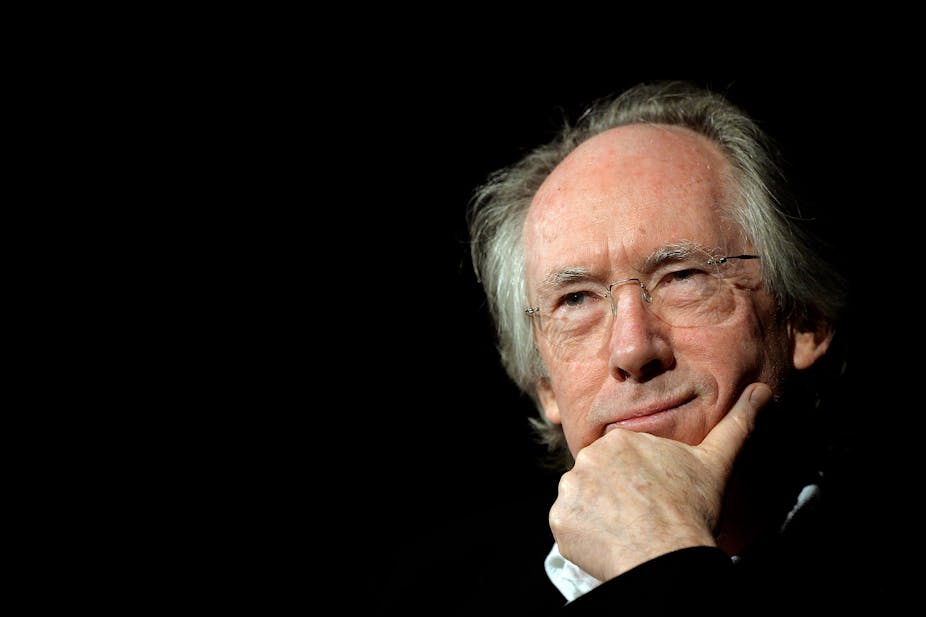Ian McEwan is one of Britain’s most successful living writers. His books are well received by both readers and critics, and he has won numerous literary prizes including the Man-Booker in 1998.
Much of his fiction has been adapted for the screen. From his controversial first novel, The Cement Garden, featuring an incestuous relationship, to the broad canvas and high-budget Atonement, a country house period drama and tragic war romance.
This year, three more works are making the transition. The BBC recently adapted The Child in Time, while On Chesil Beach and The Children Act are due for cinema release before the end of 2017.
So what is it about McEwan’s fiction that makes it such a rich source for adaptation? And how successful has the move from page to screen been?
McEwan learned his craft at the influential Creative Writing MA Programme established at the University of East Anglia in the 1970s by Malcolm Bradbury and Angus Wilson. The same course produced the likes of Anne Enright and Kazuo Ishiguro.
Perhaps as a result of this experience, McEwan’s novels are always well-crafted and stylish. They combine rich insights into the human condition with plots that comment on public anxieties and concerns. They tell stories of members of the comfortable middle class – writers, university lecturers, judges, quantum physicists and neurosurgeons.
On the face of it, one might not think that McEwan’s literary approach lends itself to screen adaptation. His characters tend to be thoughtful, questioning individuals who are presented in a prose style that draws heavily on interior monologue and reflective contemplation.
The lack of face-to-face dialogue must make it difficult for screen writers to capture the internal intellectual and emotional worlds of these individuals.
So there is perhaps an inevitable reduction of this element in some of the translations from novel to film. The interior reflections of Briony Tallis in Atonement wonderfully evoke a 13-year-old’s contemplation of the coming complexities of adult relationships, and her internal dialogue includes authentic adolescent philosophising. She wonders:
Was everyone else really as alive as she was? … If the answer was yes, then the world, the social world was unbearably complicated, with two billion voices and everyone’s thoughts striving in equal importance and everyone’s claim on life as intense.
It is Briony’s attempt to establish order in response to the complexities of the adult world that results in her wrongful accusation of sexual assault against her sister’s lover, and the subsequent upheaval of the whole family’s comfortable existence.
Briony’s thought processes are central to understanding the development of the novel’s plot. In Joe Wright’s film adaptation, the complexities of these contemplations have to be conveyed through other means – by transferring thoughts to dialogue, or the use of close-up camera shots.
In the BBC’s recent adaptation of The Child in Time, much of the novel’s emotional power and sense of panic about losing a child is achieved in a similar way. Quick cutting, the use of close-ups and the manipulation of sound all enhance superb performances by Benedict Cumberbatch and Kelly Macdonald as grieving parents Stephen and Julie.
There are, however, less successful aspects of this adaptation. One of Stephen’s closest friends suffers a nervous breakdown that manifests itself as a return to childish behaviours. This is a symptom that is perfectly credible in the novel, but seems awkward on screen. Conversations in the book about scientific discoveries and quantum physics were perhaps deemed too intellectual for the small screen – and were simply cut.
Style and substance
For filmmakers (and readers) McEwan’s style can often be unsettling in its mixing of genres and disruption of literary convention.
In one sense, his novels produce convincing portrayals of everyday lives in extraordinary circumstances, placing him in a long tradition of literary realism following Jane Austen and George Eliot. Yet several of his novels also include metafictional or magic realist elements.
Both Atonement and Sweet Tooth, for example, include epilogues that undermine the veracity of the story that is being read. The reader is unable to make straightforward assumptions about where the truth lies.
The Child in Time, which explores the complexities of our experience of time, includes fantasy scenes that move us between past, present and future. In fact, the non-realistic aspects of the novel were the source of much criticism on social media immediately following the broadcast version. This might well be due to the uncomfortable juxtaposition of the seriousness of the subject matter with the “playfulness” of such postmodern gimmicks.

Perhaps, then, the overriding aspect of McEwan’s fiction that lends itself to adaptation lies not in its intellectual aspects, nor in its (overly) clever commentary on the very nature of storytelling. It is instead the powerful evocation of our shared human sympathy for others experiencing extreme emotional situations.
McEwan’s characters are ordinary people plunged into situations in which they have to re-address the ways in which they have previously thought about the world. These situations raise moral, ethical and political questions and dilemmas, which attract the reader’s and viewer’s interest.
McEwan has said that for him, the value of fiction lies in its power to extend sympathy between individuals. This might be best suited to the contemplative nature of his introspective style of narrative fiction. But it is also clear that such extension of sympathy can, in the best hands, be translated effectively to the screen.

